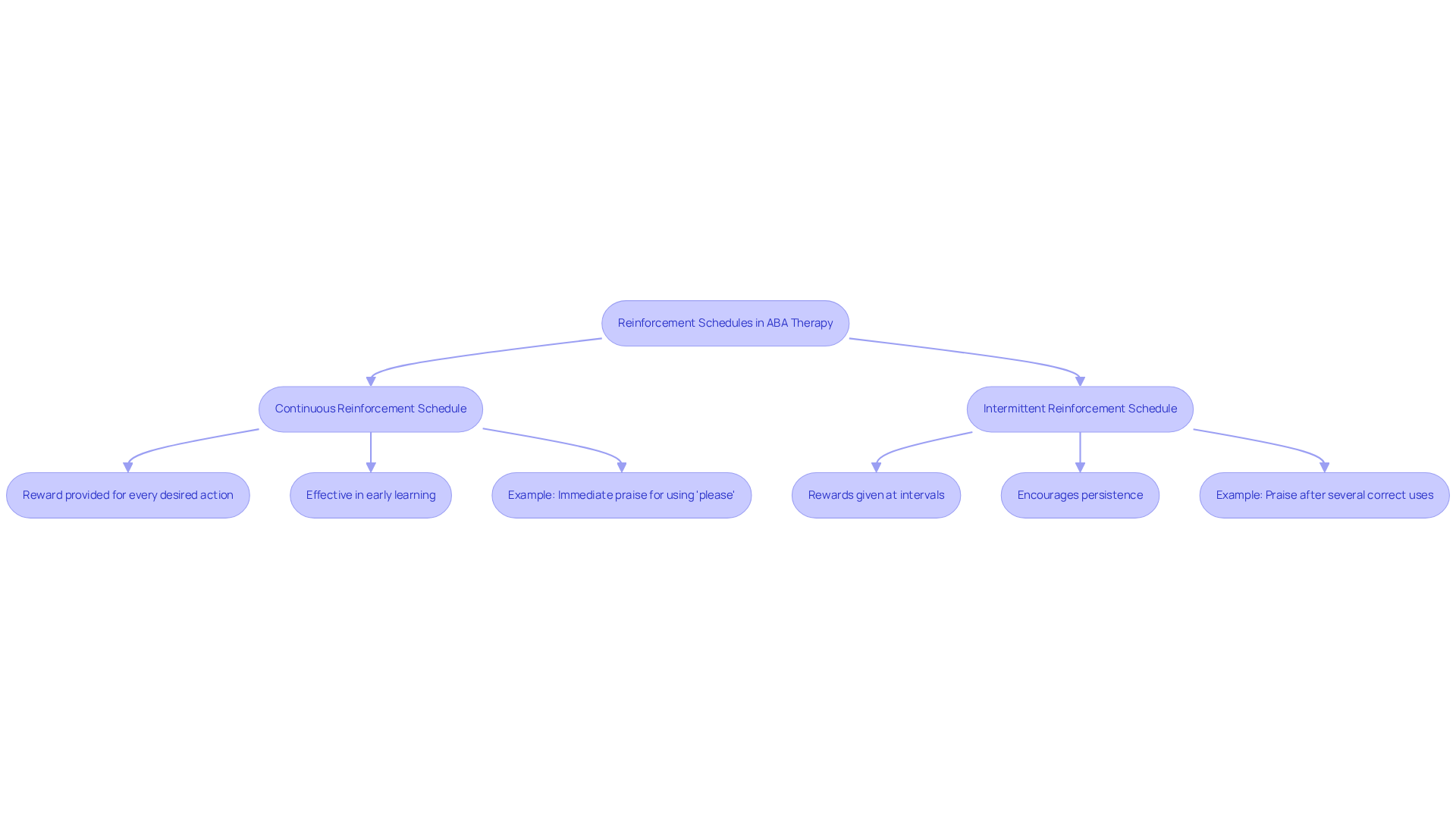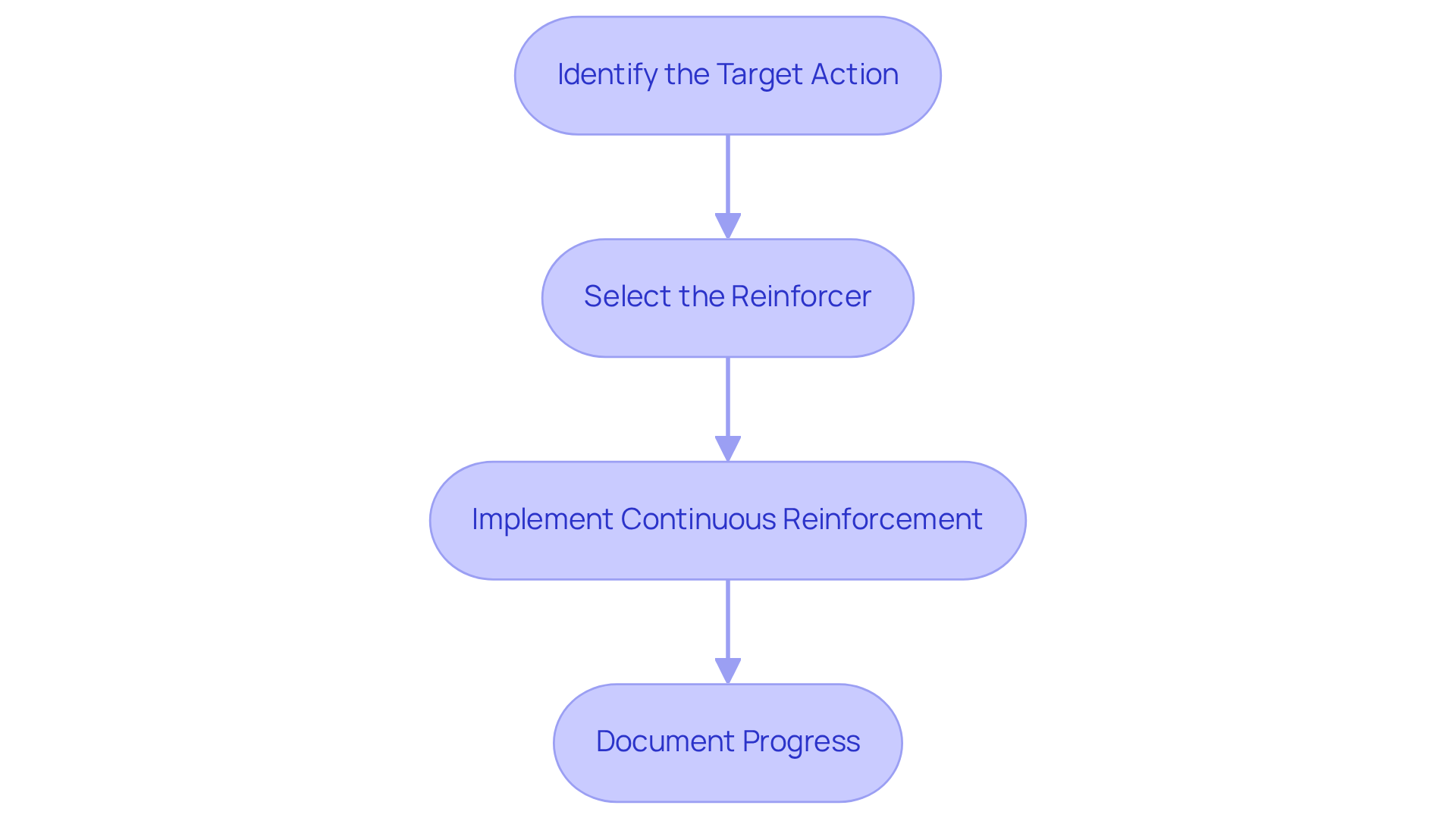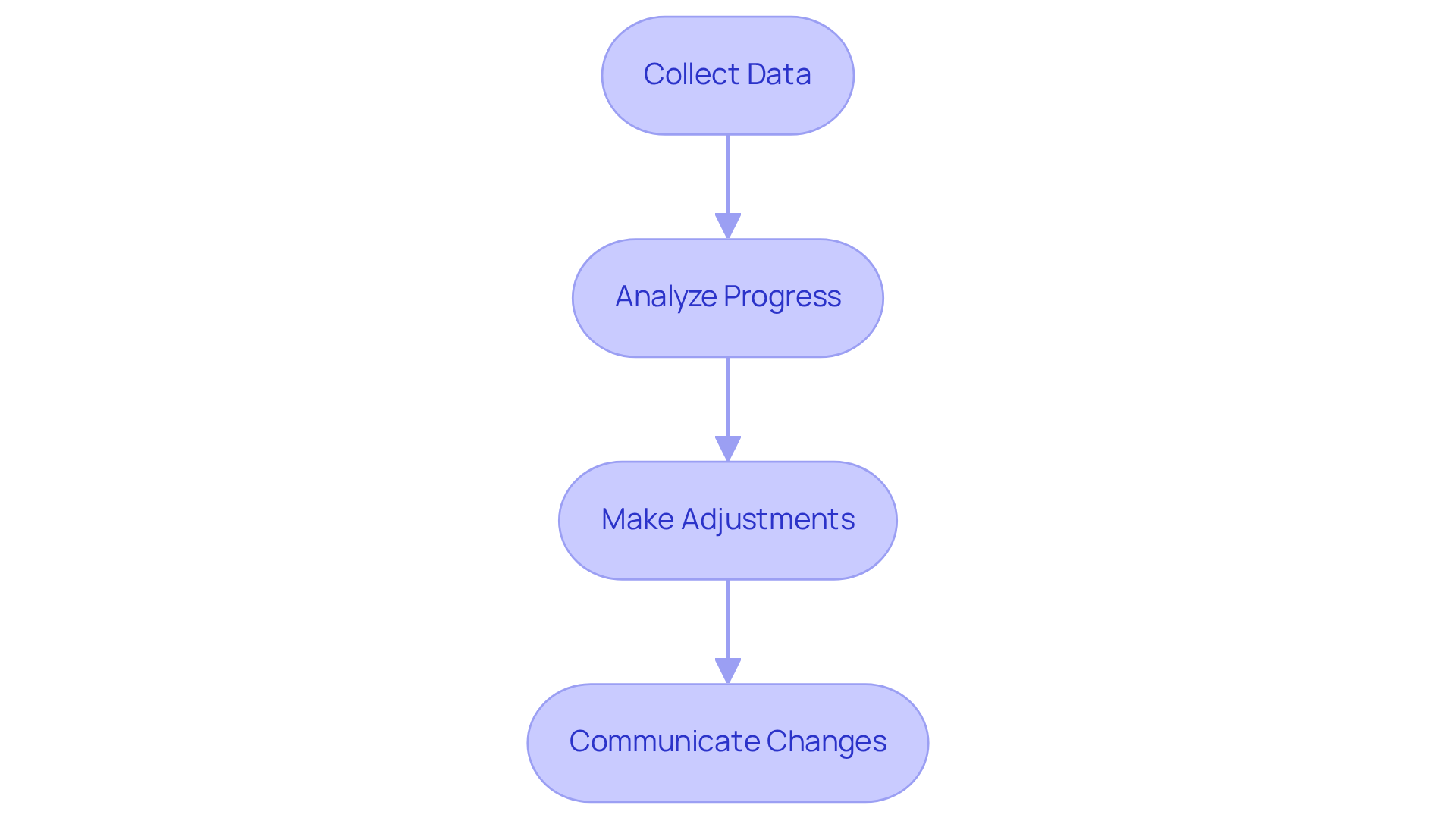June 30, 2025

The article delineates three essential steps to implement a continuous reinforcement schedule:
This method is bolstered by evidence underscoring the significance of immediate rewards in fortifying the connection between actions and positive outcomes. Such reinforcement not only enhances learning but also facilitates behavior modification within ABA therapy, making it a critical approach for practitioners in the field.
The increasing demand for Board Certified Behavior Analysts (BCBAs) underscores an urgent need for effective Applied Behavior Analysis (ABA) interventions, particularly through reinforcement strategies. This article delves into the implementation of a continuous reinforcement schedule, a method that promotes rapid learning by delivering immediate rewards for desired behaviors. However, as practitioners aim to enhance outcomes, challenges emerge in selecting appropriate reinforcers and ensuring consistency in their application.
What steps can analysts take to effectively establish and adjust these schedules, ensuring they not only motivate but also sustain behavioral change?
The demand for Board Certified Behavior Analysts (BCBAs) is projected to increase by 25% by 2026, underscoring the critical need for effective Applied Behavior Analysis (ABA) interventions. Systematic plans are methods utilized in ABA to determine how and when rewards are provided after particular actions. In ABA therapy, two main types of reward schedules are utilized: a continuous reinforcement schedule and an intermittent schedule.
A continuous reinforcement schedule involves offering a reward each time the desired action occurs, making it particularly effective during the early phases of learning. This method fosters a strong connection between actions and their consequences, facilitating rapid learning and skill acquisition. For instance, when a child learns to say 'please' while requesting a toy, they receive immediate praise or the toy itself each time they use the word correctly. This steady support encourages the conduct until it transforms into a habit.
The significance of ongoing support in behavioral analysis, especially through a continuous reinforcement schedule, cannot be overstated, particularly in 2025, as the need for effective ABA interventions continues to rise. Research suggests that children undergoing intensive ABA therapy, which frequently utilizes a continuous reinforcement schedule, demonstrate notable enhancements in cognitive, language, and social abilities. Behavior specialists stress that ongoing support is vital for developing new actions, as it offers instant feedback that improves learning outcomes.
Citations from seasoned analysts further emphasize the efficacy of ongoing support. For example, April Torres, M.Ed., BCBA, stated, "Continuous data offers a comprehensive and precise view of actions," highlighting the importance of continuous measurement in ABA. Effective execution of ongoing support in ABA therapy necessitates meticulous planning and consistency, ensuring that rewards are provided promptly and dependably to enhance their impact on conduct modification. By understanding and applying these principles, analysts can significantly elevate the effectiveness of their interventions.

To establish a continuous reinforcement schedule, it is essential to follow these steps:
Identify the Target Action: Clearly define the specific conduct you want to reinforce. For instance, if the goal is for a child to raise their hand before speaking, this action must be explicitly articulated. Effective identification of target actions is crucial; studies indicate that precise definitions can enhance the success of reinforcement strategies by up to 3. The concept of a continuous reinforcement schedule is essential in understanding behavior modification.
Select the Reinforcer: Choose a reinforcer that holds significance and motivation for the individual. This may include a favorite toy, verbal praise, or a preferred activity. It is imperative that the reinforcer is promptly accessible after the occurrence of the action. According to BCBAs, using meaningful reinforcers can significantly enhance engagement and motivation in therapy.
Implement the continuous reinforcement schedule by beginning to reinforce the target action every time it occurs. For example, if the child raises their hand, provide immediate praise or a small reward. Consistency is vital; every occurrence of the action should be reinforced to establish a strong connection between the action and the positive outcome. Token economies, where children earn tokens for preferred actions that can be exchanged for rewards, can also be an effective strategy in this step.
Document Progress: Maintain a thorough log of the instances of the target action and the associated rewards. This documentation is critical for assessing the effectiveness of the reinforcement schedule and making necessary adjustments to optimize outcomes. It is advisable to monitor not only the frequency of the actions but also the context in which they take place, as this can provide insights into the effectiveness of the selected reinforcers.
By implementing these steps, analysts can enhance the effectiveness of their interventions, ensuring that children receive the support they need to thrive.

Monitoring and adjusting the reinforcement schedule involves several key steps:
Collect Data: Regularly gather information on the frequency of the target action and the effectiveness of the reinforcement. This can be accomplished through direct observation or by employing specialized data gathering tools, such as Ensora Data Collection, which have become increasingly advanced in 2025, enabling more precise monitoring of activity patterns.
Analyze Progress: Review the gathered data to evaluate whether the target action is increasing in frequency. If there is no progress, it may indicate that the existing support is ineffective or that the individual has lost interest in the reward. Continuous assessment is crucial, as research indicates that effective data analysis can significantly enhance behavior modification outcomes. As Steven Zauderer mentions, 'The tactical application of reward systems is crucial to successful ABA therapy.'
Make Adjustments: Based on your analysis, alter the support plan as needed. This could involve choosing a more inspiring reward, increasing the frequency of rewards, or shifting to a continuous reinforcement schedule instead of a fixed interval of 5 (FI 5) as the action becomes more established. This strategic adjustment is crucial for sustaining engagement and encouraging long-term change in actions.
Communicate Changes: If working with a group or caregivers, ensure that all parties are informed about any modifications to the support schedule. Consistency across different settings is vital for effective behavior management, as uniform application of reinforcement strategies enhances reliability and fosters better outcomes in ABA therapy.

Establishing a continuous reinforcement schedule is a pivotal strategy in Applied Behavior Analysis (ABA) therapy, particularly as the demand for effective interventions continues to grow. This approach not only reinforces desired behaviors but also fosters a strong connection between actions and their positive outcomes, ultimately enhancing learning and skill acquisition. By implementing a structured reinforcement schedule, practitioners can ensure that individuals receive consistent and meaningful support, essential for successful behavior modification.
The article outlines three critical steps to effectively implement a continuous reinforcement schedule:
It is crucial to monitor progress and make necessary adjustments to ensure the ongoing effectiveness of the reinforcement strategy. These steps collectively contribute to creating an environment where positive behaviors are encouraged and sustained, leading to significant improvements in cognitive, language, and social skills.
In conclusion, the implementation of a continuous reinforcement schedule transcends a mere procedural task; it represents a transformative approach that can significantly impact the lives of individuals undergoing ABA therapy. By prioritizing consistent reinforcement and adapting strategies based on ongoing assessment, practitioners can foster lasting behavior change and enhance overall therapeutic outcomes. Embracing these best practices will not only improve the efficacy of interventions but also empower individuals to thrive in various aspects of their lives.
What is the projected demand for Board Certified Behavior Analysts (BCBAs) by 2026?
The demand for Board Certified Behavior Analysts (BCBAs) is projected to increase by 25% by 2026.
What are reinforcement schedules in ABA therapy?
Reinforcement schedules in ABA therapy are systematic plans that determine how and when rewards are provided after particular actions.
What are the two main types of reward schedules used in ABA therapy?
The two main types of reward schedules in ABA therapy are a continuous reinforcement schedule and an intermittent schedule.
What is a continuous reinforcement schedule?
A continuous reinforcement schedule involves offering a reward each time the desired action occurs, making it effective during the early phases of learning.
How does a continuous reinforcement schedule facilitate learning?
It fosters a strong connection between actions and their consequences, facilitating rapid learning and skill acquisition by providing immediate rewards.
Can you provide an example of a continuous reinforcement schedule in practice?
An example is when a child learns to say 'please' while requesting a toy and receives immediate praise or the toy itself each time they use the word correctly.
Why is ongoing support important in behavioral analysis?
Ongoing support is vital as it provides instant feedback that improves learning outcomes, helping to develop new actions effectively.
What benefits do children experience from intensive ABA therapy that uses a continuous reinforcement schedule?
Children undergoing intensive ABA therapy demonstrate notable enhancements in cognitive, language, and social abilities.
What do behavior specialists emphasize regarding ongoing support in ABA therapy?
Behavior specialists stress that ongoing support is essential for developing new actions, as it offers immediate feedback that enhances learning.
What is necessary for the effective execution of ongoing support in ABA therapy?
Effective execution requires meticulous planning and consistency to ensure that rewards are provided promptly and dependably.
Our expert recruitment strategies and AI-driven sourcing ensure that you receive top-notch candidates quickly, without compromising on quality. Whether you’re looking for BCBAs, Clinical Directors, or RBTs, we’ve got you covered.